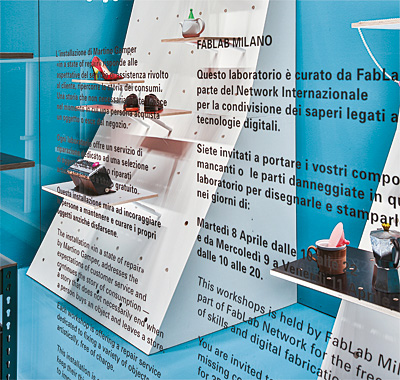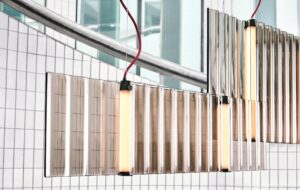|
Stalls were placed on the street outside La Rinascente |
||
|
The London-based Italian designer curated an exhibition featuring the people and processes that step in when design goes wrong “There was a bookbinder, clothes mender, toy fixer, a leather stitcher, shoe mender” – Martino Gamper lists the participants of his “In a State of Repair” pop-up during the Milan Furniture Fair. “Someone fixing chairs, bikes, and a 3D printer for making spare parts … ” Of course, repair is not a new topic in the design world: the past few years have seen a growing number of repair groups across the world, from the UK and the Netherlands to the USA and Brazil. But what was interesting about this pop-up was that it wasn’t down a back street; it was spilling out of major department store La Rinascente. Rather than try to encourage people to buy new wares, the store offered to fix the public’s broken goods. “Maybe it is time to push a bit the boundaries of what a shop window – or even a department store – does,” says Martino Gamper, who curated the event as part of a collaboration with Serpentine Galleries in London.
A display of the repaired items in the store windows “I think shops are realising they have to offer more.” Each craftsman was situated in a stall – designed by Gamper specifically for the task by at hand – on the street in front of the department store’s shop windows. Here, besides fixing goods, “Repair was being branded a little bit,” he says. “Things weren’t just fixed as they were. We had a conversation with each artisan about how they would intervene – so what colour thread they might use, or what material.” By “branding” repair, perhaps “repair becomes fashionable,” says Gamper. “If it generates enough momentum, then maybe it can become standard.” As with Gamper’s show Design is a State of Mind at the Serpentine Sackler Gallery in London, the designer also wanted to use the platform to question what the role of a designer could be. “Rather than building a window installation that has to be dismantled and put in the bin, I tried to subvert [the brief] and do something that would create a job, and give these people visibility – and show that design can facilitate,” he says. “They all got paid for their work, with a nice fee.” |
Words Anna Bates |
|
|
||



















